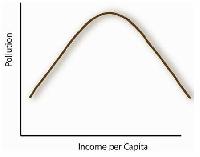
The environmental Kuznets curve (EKC), shows the relationship between economic progress and environmental degradation through time as an economy progresses. It describes that as countries develop initially, pollution increases. But later, as the economy achieves further development, pollution decreases. Empirical studies show that usually environmental factors like water, air etc. shows this path for several coutnries. Following diagram shows that relationship between economic development and level of economic degradation.
The curve is known after economist Simon Kuznets who made a well-known study about the relationship between inequality and economic development. In that study also, the relationship between inequality and economic development gives an inverted U shape; showing an increase in inequality first with economic development and then, inequality decreases with further development and per capita income.
The inverted U shape (∩)
When the stages of economic development is expressed on the X axis and Environmental degradation on the Y axis, the Environmental Kuznet curve gives an inverted ‘U’ shape (∩).
The Environmental Kuznets curve shows an increasing pollution with initial development. But further economic progress brings down pollution. Reason for this decline in pollution with economic progress is that at low incomes, people tend to value development over environmental quality. They exploit resources and nature. With wealth accumulation, they are willing care more about environmental quality and its improvement.
The relationship between environment and economic activities is very strong. For example, uncontrolled expansion of economic activities has now caused global warming and climatic changes. Economic activities especially industrial activities have to be regulated for the protection of the environment.









